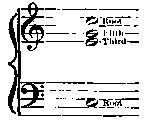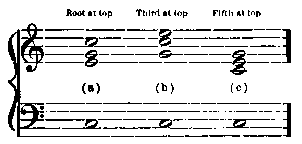Harmony Book For Beginners - online book
Scales, Intervals, Common Chords, Dominant Seventh Chord and Melody Making.
| Share page | Visit Us On FB |
|
COMMON CHORDS 31
CHAPTER IX
COMMON CHORDS
Since a Triad is made up of but three different sounds, it follows that if we attempt to write music in four parts, or for four voices, one member of the Triad must be doubled, or used twice. The best member to double is the Root.
As an example take the C Major Triad: |
||
 |
||
|
|
||
|
In this shape it is known as a Common Chord. |
||
|
We may display the Common Chord on two staves, using Treble and Bass Clefs, |
||
|
|
||
|
thus: |
||
|
|
||
 |
||
|
As it now stands, having the Root in the Bass, this chord may be written in three Positions, thus: |
||
|
|
||
 |
||
|
Bear in mind that it is the same chord, no matter how its component tones may be moved about.
It is important to recognize these three Positions both with the eye and the ear. |
||
|
Let us play them. The original position (a), having the Root at the top, is known as the Root Position or Octave Position. In this position the chord has a solid and substantial sound. With its Third at the top (b), the chord is said to be in the Third Position. This position seems to give an effect of lightness and grace. With its Fifth at the top (c), the chord is said to be in the Fifth Position. This position seems to indicate something to follow or to ask a question. |
||